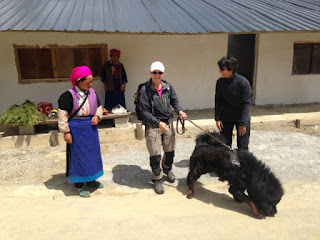Fantastic day in the snowy mountains in Balagezong National Park. Day started with great views from the hotel carpark

and a very excited hotel staff and guide telling us that according to Buddha you must be very lucky if you have good weather when you go to a holy lake or mountain.

We passed Lake Napa again from a great height

and several mountain terraces (probably growing grapes; but more on that later)
We drove for a couple of hours (76km) from Shangrila to reach the base of the mountains in the Shangri la Grand canyon.
The canyon is the meeting point between Sichuan, Tibet (autonomous province) and Yunnan.
It is a typical U shape with precipitous sides of 200m- 1000m and has many small canyons crisscrossing it.
The start did not inspire us much as the new hotel (opens 1 May 2016) looked very austere, with the inevitable neon signs.
Several large green buses were lined up to take tourists up to the first 2 stations:
1. For rafting at 2300m. We skipped the rafting due to time (and not knowing about it before as I am sure Sarah would have jumped at the chance of a kayak)
2. Bala village at 2900m. A farmer who lived in Bala village had the vision to open up the area for tourism; he joined forces with Yunnan government to build a road to connect Bala to the outside world.
Bala in Tibetan means a village people who come from Batang in Sichuan.
History records that many centuries ago Tibetan people searched for a place to live far away from war and misery. They settled down after overcoming much difficulty and Bala became the symbol of an ideal home and paradise.
Had we finally found the source for the James Hilton novel /Frank Capra film Lost Horizon?
On a Tuesday morning in glorious sunshine the place was deserted. We hired a 4WD (and the compulsory guide plus driver) to take us as far up the mountain as we could. We were aiming for the 3rd station at 4300m.
We arrived at Bala village to discover it was mostly empty. It was destroyed by an earthquake at the end of 2015 and is now in the process of being rebuilt.


This station offered our first view of the Holy Mount Balagezong (Gezongsongben )

This mountain is 5445m above sea level, snowcapped all year round and named Gezongsongben after 3 Tibetan princesses turned to stone. A sacred spot for Tibetan buddhists. Lobsang prayed and we all walked clockwise around the Stupa.
It was peaceful and still; we had the whole of the National Park to ourselves. We passed some abandoned nomad cabins
At 3900m we hit deep snow, abandoned the 4wD and walked the rest of the track to the 3rd station at 4300m.

The views were splendid and magnificent and breathtaking.
A fantastic place to rest, have lunch and marvel at the scenery – we were surrounded by all the Balagezong mountains.

One of the most famous is the Shambhala Stupa (named this as it resembles the places where all the sacred relics and scriptures are stored in a monastery) A pyramid shaped peak coated with snow, glaring up to the sky.

On the top pass (3rd station) Buddhist monks pray and light incense 3 times a year. Such was our luck that this was one of those days and as we descended the monks were on their way up to pray.
Snow started to melt and all the mountains glistened in the sun. It was truly magical.

Descending from 4300m to 2300m then back to the hotel at 3300m made us both incredibly tired.
We had a brief stop to buy
a.
some black pottery from Nixi; quick look at the kiln
was followed by meeting the potter himself , wife and child. We believe the potter is about 14 years old. We left with a dragon teapot and burner
b.
bread for tapas dinner with fire and local wine in the room
We opted for an early night, wine and Aussie cheese (leftover Holy Goat seemed apt for the occasion). The wine was “interesting”; fruity and thin for a Cab Sav but drinkable. A wonderful day.
 Jo decided to slip class today as she is thoroughly enjoying the
serenity of the area - and obviously fears it may the last time for quite a
long time that she will enjoy such peace!
Jo decided to slip class today as she is thoroughly enjoying the
serenity of the area - and obviously fears it may the last time for quite a
long time that she will enjoy such peace!

























































